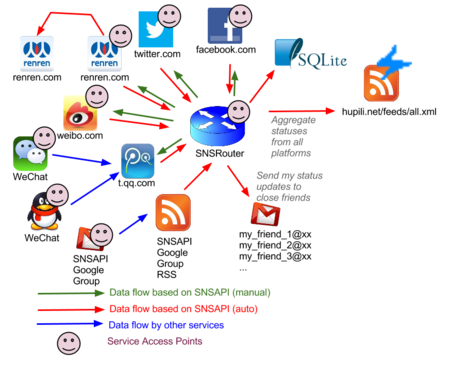User:Hupili.net
HU, Pili
- My IndieWeb Identity Site: http://hupili.net
- My GitHub: https://github.com/hupili/
- My Twitter: https://twitter.com/hupili
Tools Related with IndieWeb
My Setup
Silos I'm using regularly:
- Renren, the large OSN in China. It's a Facebook like model: http://www.renren.com/
- SinaWeibo, ("weibo" in Chinese means "micro-blog"). It's a twitter like model: http://weibo.com/
- TecentWeibo. It's another micro-blogging service in China. Due to the broad production line of Tecent, TecentWeibo has some unique access point (e.g. WeChat from a mobile device). http://t.qq.com/
Aggregation and distribution points on my site:
- The aggregated status update from those silos: http://hupili.net/feeds/all.xml . It's currently a mix of all materials. I'll separate the English and Chinese messages later.
Following is a visualization of my silo setups.

More detailed description and updated figure can be found at the article: http://blog.hupili.net/articles/silo.html
My IndieWeb Related Articles
- "Degree of Decentralization: Distributed- , Federated-, and Meta- Social Network", [1]
- "A Meta Social Networking Approach Towards Decentralization", [2]
- "My Social Silo Settings", [3]
About IndieAuth
(I have not find a proper location for this piece of comments; feel free to move)
The IndieAuth model is interesting. I think the essence is to decouple ID provider and ID verifier. The two components were often binded in previous models, which is not natural in our real life. Consider a real-world example: I want to make friends with A and A want to make sure whether I'm me before that. It's very absurd for me to show A my ID card. Instead, there may be a B who has verified me some time ago (by looking at my ID or through a longer chain of trust). In B 's mind, my ID and my face have been binded. Using this information, B can come to tell A that I am indeed me.
